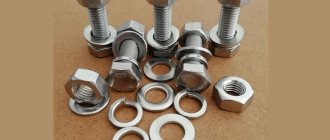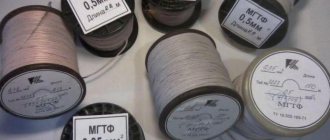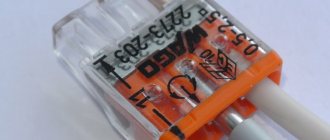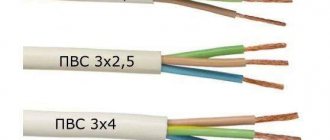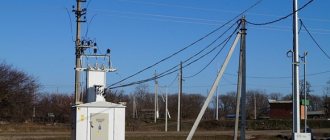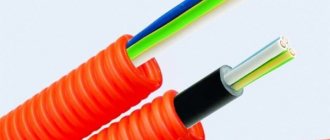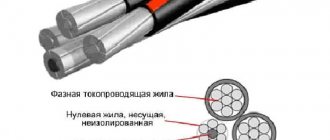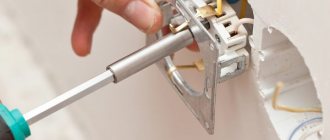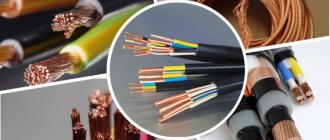Cable and wire products include a variety of types of wires that are designed to solve electrical problems. Moreover, when performing household electrical installation work, it is customary to use either aluminum or copper wire. Other materials are not popular. If there are no restrictions on weight and cost, then it is better to use copper products. But copper has a significant drawback - it oxidizes in the open air, which often leads to deterioration of contact. As a result, the junction begins to conduct electric current less and less well, a voltage drop occurs, the connection heats up more and more, and over time the electrical wiring may catch fire.
Therefore, to prevent short circuits and ensure a safe connection, it is better to use aluminum wiring.
Of course, aluminum also has its drawbacks. Its conductivity is 1.5 times lower than that of copper.
Why aluminum
Although aluminum conductors do not have high performance characteristics, they do:
- cheap compared to copper;
- are light in weight. Thus, aluminum wire is 3 times lighter than copper;
- universal in use - the operating temperature range is quite wide from –50 ⁰С to +50 ⁰С;
- resistant to high humidity - up to 98%;
- resistant to corrosion damage. Although there are nuances here too: the surface of any aluminum product in air is instantly susceptible to oxidation and is immediately covered with a film that protects the wire from further oxidation.
It would seem that it is more profitable to use aluminum products than copper ones. But she also has a number of negative qualities. Thus, the disadvantages of aluminum conductors are the low mechanical strength of the material, and the connection of such wires causes problems in the passage of current through them. Besides:
- the conductivity of aluminum is not high enough - 0.0271 Ohm×mm²/m;
- aluminum is susceptible to oxidation, and its film, which appears after it, does not conduct electricity well. But here, too, there is a catch: this film consists of particles of the upper layer of the conductor itself, which separates from the overall structure and thereby reduces its diameter. As a result, the initial resistance characteristic of aluminum wire increases;
- Due to the increased resistance of the film on aluminum wiring in the places where its individual parts are connected, the contact resistance increases, which causes the wiring to heat up. Therefore, if the service life of the aluminum wires used is exceeded, this may lead to a fire;
- Aluminum is not elastic and very brittle. Moreover, fragility increases after overheating.
Whether to use aluminum or copper wires depends on the tasks and priorities.
Types and features of the use of aluminum cables
Power cables with an aluminum core, offered by MTD "Energoregionkomplekt", are used for the transmission and distribution of electricity in stationary installations. Let's look at the most popular types of such cables and the features of their use.
AVVG cable
- cable with aluminum core, insulation and sheath made of PVC plastic, unarmored. It is used for laying single cable lines in cable structures and premises.
AVVGE cable
— cable with an aluminum core, with insulation and sheath made of PVC plastic, unarmored with a copper screen under the sheath. It is used for laying single cable lines in cable structures and premises, in places where the cable is subject to higher requirements for protection from electromagnetic interference.
Cable AVBShv
— a cable with an aluminum core, with insulation and sheath made of PVC plastic, armored with galvanized steel tapes, with a protective hose made of PVC plastic. It is used for laying single cable lines in cable structures and premises, for laying in the ground. In cases where higher demands are placed on the cable for its safety from mechanical damage during installation and operation.
APvBShv cable
— cable with aluminum conductors, insulated with cross-linked polyethylene, armored with galvanized steel strips, with a protective PVC hose. It is used in the same way as the AVBShv cable, but unlike cables with PVC insulation, it has a higher (+900C) permissible core heating temperature.
Application of aluminum wires
The most popular brands of aluminum wires are SIP and AVVG.
The AVVG universal power cable can be used under any conditions, sudden temperature changes and high humidity levels - up to 98%. This is a cable with aluminum conductors and polyvinyl chloride insulation that is quite tensile strength and resistant to aggressive environments.
Such wires are intended for stationary single electrical wiring installations that will not be subject to significant mechanical loads, for example:
- in open areas where the impact of climatic factors is maximum;
- in voids that are located in building structures;
- in basements and rooms that are subject to flooding;
- rarely underground.
Such wires can be used for operation in systems where the voltage passes no more than 660 V, and for conductors with a core cross-section of more than 50 mm, use in networks that carry a voltage of 1000 V is permissible.
The marking of aluminum SIP wires means that they are intended to provide and distribute electricity in overhead power lines and in lighting electrical networks with voltages up to 35 kV. They can be used as an alternative to traditional bare wires because they have an insulating layer of polyethylene. The advantages of SIP include the following properties:
- prevent the risk of overlapping and twisting of wires, which is typical for uninsulated lines;
- help reduce the width of the clearing, and when laying electrical lines in the city, they do not require the allocation of a large right-of-way of land;
- reduce operating costs by up to 80%;
- eliminate the risks of illegal connection and theft of electricity.
Advantages of aluminum power cables
When compared with copper cables, power cables with aluminum conductors have both advantages and disadvantages. The disadvantage is low throughput. The main advantage is the low cost of production.
Network parameters such as reliability and long service life are ensured through the use of high-quality cable and wire products, which have high technical and operational properties. In addition, the main line made of AVBbShv 4x16 power cable must fully comply with regulatory documents and be laid in accordance with the requirements... Read more →
Cable AAShv 3x120 is used to create power lines. It is equipped with aluminum cores, specially impregnated paper insulation, an aluminum sheath and a polyvinyl chloride coating. Low cost is one of the advantages of the product. At the same time, it is characterized by resistance to corrosive activity... Read more →
The AABl-10 3x240 cable is used for the installation of power transmission lines. It is equipped with 3 conductive aluminum elements with a cross-section of 240 mm2, covered with impregnated paper insulation, an aluminum layer and protection with metal strips. When installing a conductor in a permanent network... Read more →
The cable APvBBShP 4x95 consists of four conductive parts made of aluminum wire. Their area is 95 mm2, they have an insulating coating, a shell made of cross-linked polyethylene (PEX), and armor made of a pair of galvanized tapes. Since 2012, a slightly different product labeling has been used - ... Read more →
The AVVG 4x25 cable is a wire for laying power lines, the cross-section of its conductive part is 25 square meters. mm. The product contains four cores made of aluminum. It is necessary for the installation of fixed power lines in everyday life and industry at maximum ... Read more →
The ASBL-10 3x185 cable transmits and distributes electrical energy in networks with load parameters of 50 Hz and 10 kV. When using the wire in a DC network, voltage up to 25,000 V is allowed. It can be installed in areas with tropical, temperate and cold... Read more →
The APvBbShp 4x120 cable is used when laying power lines. An armoring layer of a pair of tapes (steel coated with a thin layer of zinc) allows the conductor to be used under conditions of possible mechanical stress. In the cross-section of the wire there are four cores with an area of 120 mm2, an insulating layer is placed on top of them, ... Read more →
The AVVG 4x16 cable belongs to the power group of conductors and is characterized by the maximum area of aluminum current-carrying conductors in its class - 16 mm2. There are four wires in the wire cross-section. Most often, the cable is used in electrical networks and power lines for permanent connection of equipment. Suitable… Read more →
The AVBBShv 4x185 cable is presented in the form of a current-carrying aluminum part coated with polyvinyl chloride. This is a product with armor, it consists of four cores, the area of which is 185 mm2. Depending on the marking, the design of the conductor differs. If the name contains the index “ozh” (“ok”), the wire... Read more →
The AVVG 4x120 cable is a conductor that consists of four current-carrying cores with a total area of 120 mm2, an insulating layer and a coating made of PVC composite material. The insulating coating is yellow-green in color, with individual stripes of colors arranged diametrically. This wire is intended for… Read more →
Source: kabeltehsnab.ru
Rules for using aluminum wires
Based on the above, aluminum conductors are not considered the most optimal for laying wiring in residential buildings. But their use is possible subject to the following rules:
- if it is necessary to connect aluminum wires, then it is necessary to use exclusively a mechanical method, clamping contacts and a lubricant specially designed for this, which will reduce the likelihood of contact oxidation;
- do not connect aluminum wiring directly to copper wiring;
- periodically tighten the screw connections - during operation, aluminum begins to “leak” from under the clamping point, and this can lead to a decrease in the contact area and burning of the places where the wires are connected;
- monitor service life.
If you plan to change the copper electrical wiring in the house and install aluminum, but not in all rooms, but partially, then know that this can be done, but subject to some nuances:
- PUE prohibits the use of aluminum wire with a diameter of less than 16 mm² during installation;
- Welding of aluminum wires is not permitted.
What to do with old wiring?
The old aluminum wiring definitely needs replacing. Its main drawback is the maximum load it can withstand. The abundance of modern electrical appliances in homes has significantly increased the load on the network.
To reduce the load, you will need to lay several additional aluminum lines. Such lines require a boiler, washing machine and other powerful appliances. In order not to spoil the existing repair, new wiring can be hidden in special decorative boxes.
How to properly connect aluminum wires
Taking into account the advantages and disadvantages of this type of conductor products, it is customary to use screw or spring clamps when connecting them.
Before connecting aluminum wires using screw terminals, it is recommended:
- clear their ends from the insulating coating by 2 cm;
- clean them with fine-grained sandpaper;
- twist the bare ends into a ring with a diameter slightly larger than the diameter of the clamping screw;
- put the resulting loop on the clamping screw and screw it in as far as it will go.
The disadvantage of this connection method is that due to the leaking property of aluminum, the screws will have to be constantly tightened, so they must be easily accessible.
In the case of using the spring connection method, it is necessary to insert the pre-stripped cores into special terminal blocks. This will avoid re-tightening the contacts, since they will be securely fixed by the spring located inside the terminal block.
Twisting of aluminum wires is not allowed by the rules of electrical installations (PUE).
Connecting aluminum and copper wires: what are the risks?
Sometimes it happens that when laying aluminum wires it is not possible to avoid connecting with copper wires. But, as you know, direct contact connection of copper and aluminum in electrical wiring is not recommended and even dangerous. What to do?
It is impossible to twist wires made of two different metals together, because aluminum and copper differ in their properties, chemical structure, and current conductivity, and the resistivity of an aluminum wire differs from that of a copper wire.
This also applies to the protective film that forms after oxidation: on copper products it conducts electric current, but on aluminum the film has such a strong resistance that it practically does not allow current to pass through and, accordingly, is practically resistant to heating. And after heating and cooling occurs several times in a row at the junction of copper and aluminum wires, they are greatly weakened, which can lead to overheating, sparking and even fire.
Also, in places where copper and aluminum wiring are connected, a galvanic couple can occur. It causes dissociation of the oxides of electrical conductors, contributes to the destruction of the metal structure and the formation of voids and cavities in it, which in turn contribute to a reduction in their cross-section and a deterioration in their ability to pass electric current.
In a word, the connection of aluminum conductors with copper leads to electrocorrosion of the metal and its destruction.
But if you need to connect different wires, then in this case you should not use soldering of aluminum and copper wires, but bolted connections and terminals. Thanks to this, higher security can be achieved than using the conventional twisting method.
general information
Aluminum, along with copper, is an excellent conductor of electricity, which is widely used for laying power supply systems. Until 1991, both conductors were allowed to be used in the construction of residential and industrial buildings. The developing instrument-making industry has led to the rapid equipping of houses and apartments with modern household appliances, which has led to an increase in the load on internal electrical lines.
This was the reason that the requirements contained in PUE-6 were changed. From that moment on, the use of electrical wiring in buildings and structures was prohibited.
In 2003, PUE-7 was introduced, allowing the use of aluminum for the construction of supply and distribution lines. In addition, the cross-section of the core must be at least 16 mm2 (squares).
Important! The service life of aluminum wiring depends on its quality and is in the range of 10-15 years. If there is double insulation - 20-25. However, the manufacturer's warranty does not exceed 5-10 years.
Contents of the Electrical Installation Rules Source consultant.ru
However, in apartment buildings built before 1991 there are still quite a lot of electrical wiring sections made from old aluminum wire. Moreover, the cross-section of its veins is only 2.5 and even 1.5 square.
Healthy! PUE (Electrical Installation Rules) is a book intended for engineering and technical personnel involved in the design, installation and operation of the electrical part of lighting and electrical equipment of buildings, structures and structures. Contains all the necessary requirements regarding this issue.
Aluminum wire extension: what is it and when is it used?
When carrying out electrical installation work, incidents and difficulties occur: the wire may break on its own due to “old age,” the wall was accidentally cut while drilling, the length was not calculated, and so on. What to do in such situations? The solution to these problems is to build or extend the wire.
How to extend aluminum wire correctly? To do this, there are several ways to lengthen a rather fragile aluminum wire:
- the use of a special heat-shrinkable tube, which is placed on the ends of the wires;
- extension using a block;
- connecting aluminum wires to each other using an aluminum spiral followed by insulation.
If you are using aluminum electrical wiring that is 20–30 years old, using the method of lengthening it becomes unsafe, because in the age of using powerful electrical appliances, the risk of fire increases.
Rules for using aluminum wiring
If for any reason you are forced to use aluminum wiring at home, then you should consider the following conditions:
- the cross-section of the wire must be 2.5 mm or more;
- When connecting, it is necessary to use contact clamps and special lubricant to prevent oxidation of contacts and maintain low contact resistance in junction boxes.
- The best way to connect aluminum wires is welding.
- Periodically, every 1-1.5 years, it is necessary to tighten the contacts, due to its fluidity properties.
It is also worth remembering the maximum loads on aluminum wires of various sections. We provide such data in the following table:
Regardless of the type of aluminum cables or wire cross-section, it is necessary to follow standard fire safety rules and operating rules for aluminum wiring. In this way, you will protect yourself and your home from accidents, unforeseen situations and disastrous consequences.
Where can I buy
You can purchase the wire as quickly as possible at your nearest specialized store. The optimal option, in terms of price-quality ratio, remains purchasing from the AliExpress online store. Mandatory long waits for parcels from China are a thing of the past, because now many goods are in intermediate warehouses in destination countries: for example, when ordering, you can select the “Delivery from the Russian Federation” option:
| 100m 1.0mm 18 silver anodized aluminum wire | Aluminum wire 99.99% high purity | Aluminum Wire Keyue AWS A5.10 ER4043 |
| Colored Aluminum Wire 1mm, 1.5mm, 2mm, 2.5in | Aluminum Flux Cored Welding Wire | 1.6mm 2.0mm Universal Copper Aluminum Welding Electrodes |
